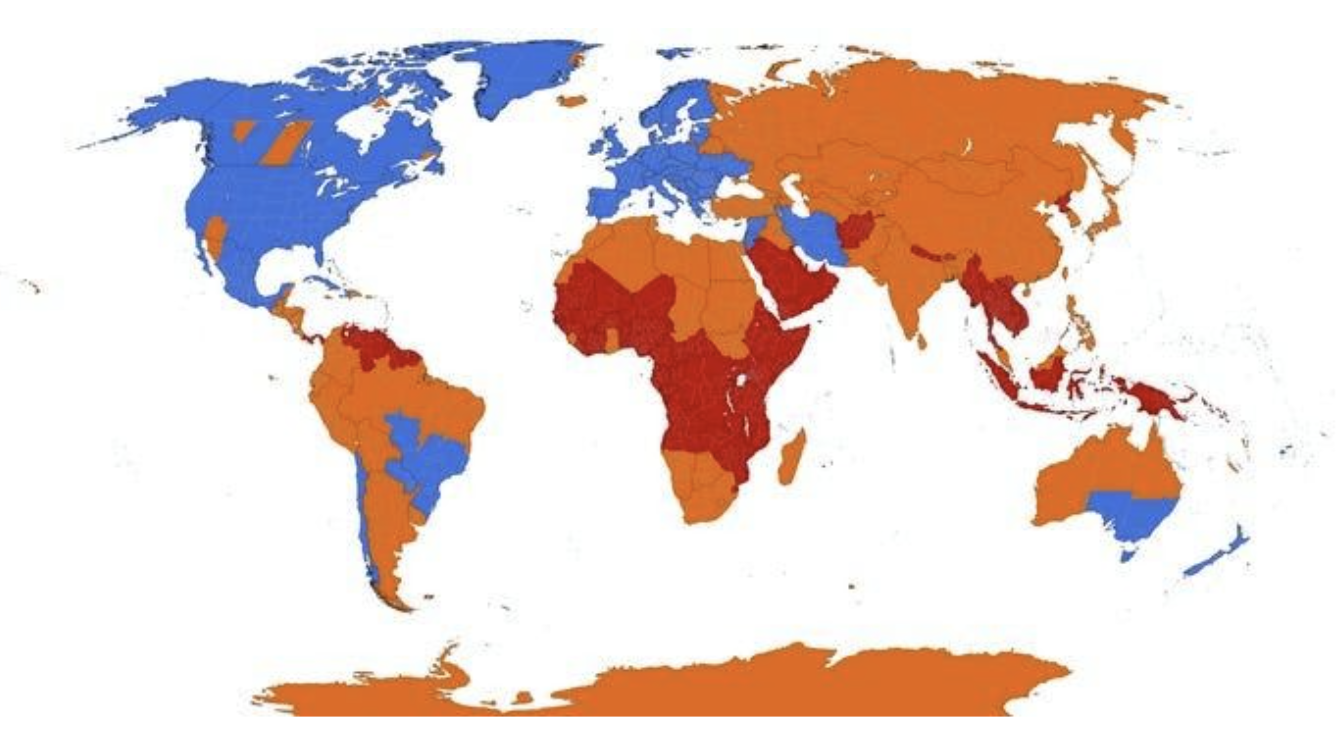Changing your clocks from standard time to daylight saving time has been a ritual in the United States since the government began enforcing daylight saving time in 1966. Across the world, numerous countries have adopted the twice-a-year, one-hour time change.

Where in the world daylight saving time is used (blue), abolished (orange), and never instituted (red). Paul Eggert/Wikipedia (CC BY-SA 3.0)
Whether to keep or discard the practice is widely debated. So, what is better for a good night’s sleep –– standard time or daylight saving time?
Early Savers
Benjamin Franklin proposed something similar to daylight saving time. However, our modern system was inspired by bug hunter George Hudson who wanted a two-hour summer adjustment to give him more daylight for insect harvesting. Hudson’s 1895 idea gained supporters, including Winston Churchill, who proposed it at the dawn of World War I. In 1918, the U. S. Congress not only enacted the country’s first daylight saving law but also defined its time zones. The law was repealed just one year later. For decades, there was no uniformity with time –– traveling just 35 miles from Steubenville, Ohio, to Moundsville, West Virginia, meant passing through seven time zone changes!
The Uniform Time Act of 1966 did more than make daylight saving time the law of the land–it also gave states the right to stay in standard time year-round. (To remain in daylight saving time year-round requires an act of Congress.)
Daylight saving time seemed like a good idea. Moving the time ahead one hour in the spring saved energy since it would be lighter later. Except. . . a study in Indiana where some counties didn’t observe daylight saving time showed that while the use of lights might have diminished, air conditioner use skyrocketed. People who didn’t observe the time change paid higher electric bills after daylight saving time became a statewide practice in 2006. However, there is evidence that daylight saving time has an effect on crime rates since without it many people are leaving work in the dark –– making them more vulnerable to muggings. Indeed, a Brookings Institute study showed that when daylight saving time begins, robberies were reduced by 7 percent from the previous day, and overall crime went down by 27 percent in the additional evening hour of sunset gained on that day.
The safety advantages of evening sunlight are one reason given by advocates of year-round daylight saving time. In other words, after “springing forward” in March, we wouldn’t set our clocks back in the fall. Those winter afternoons where it seems dark by 4 p.m. would become a memory. Unfortunately, so would bright December mornings, where many would head to work while the stars are still out.
Out of Rhythm
There’s no question that losing that hour in the spring has a health impact. Many report feeling “jet lagged” for days after the time change. Some people are negatively affected by the switch to daylight saving time for days, or even weeks. That’s because it alters the circadian rhythm. This sleep-wake cycle is regulated partly through the hormone melatonin which is activated by light.
Yet it not only means potentially sacrificing an hour of slumber. There is a link between the springtime change and an increase in strokes, cardiovascular episodes, and auto accidents. In addition, experts estimate the bi-annual time change costs the United States around $430 million every year. The increase in heart attacks, workplace injuries, and lowered productivity all account for the added costs. There are even other studies reporting the adverse consequence of the time change impacting student test scores and stock market returns.
Despite this, many legislatures hoping to eliminate the twice-yearly time change are advocating for permanent daylight saving time. In 2018, Florida passed a law making it permanent. Although it can’t take effect without congressional approval, given the state’s reliance on tourism it’s natural that lawmakers would want to encourage visitors to stay out late (and spend money) when it’s still light. Still, sleep experts point to studies that show getting up earlier can have a positive effect on health. The Society for Research on Biological Rhythms put out a statement supporting year-round adoption of standard time, in part because it would improve people’s sleep, cardiac function, weight, cancer risk, and alcohol and tobacco consumption. The American Academy of Sleep Medicine also came out in favor of standard time. Two states — Arizona and Hawaii — and the U.S. territories of American Samoa, Guam, the Northern Mariana Islands, Puerto Rico, and the Virgin Islands also observe permanent standard time year round. Also more than 60% of the countries in the world use standard time all year, including Japan, China, and India.
Numerous polls show most people want to ditch the time change (a recent one showed only 28% support the twice-a-year practice.) Currently 32 state legislatures have taken up adopting year-round daylight saving time. As the research evidence is considered, other states could end up joining Arizona and Hawaii in abstaining from the annual daylight-saving-time madness. As we move toward that possibility, we may find it easier to save lives and money rather than chase the daylight.
References
- Does Daylight Saving Time Save Energy? Evidence from a Natural Experiment in Indiana
- Fighting crime with Daylight Saving Time
- Are Daylight Saving Time Changes Bad for the Brain?
- The Society for Research on Biological Rhythms statement on standard time.
- Daylight saving time: an American Academy of Sleep Medicine position statement
- Gaski, J. F., & Sagarin, J. (2011). Detrimental effects of daylight-saving time on SAT scores. Journal of Neuroscience, Psychology, and Economics, 4(1), 44–53
- Kamstra, Mark, J., Lisa A. Kramer, and Maurice D. Levi. 2000. “Losing Sleep at the Market: The Daylight Saving Anomaly.” American Economic Review, 90 (4): 1005-1011
- We Call It ‘Daylight Saving Time’ But It Costs Us Millions